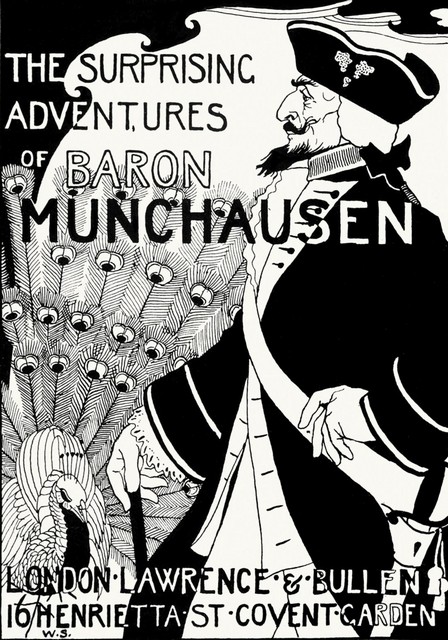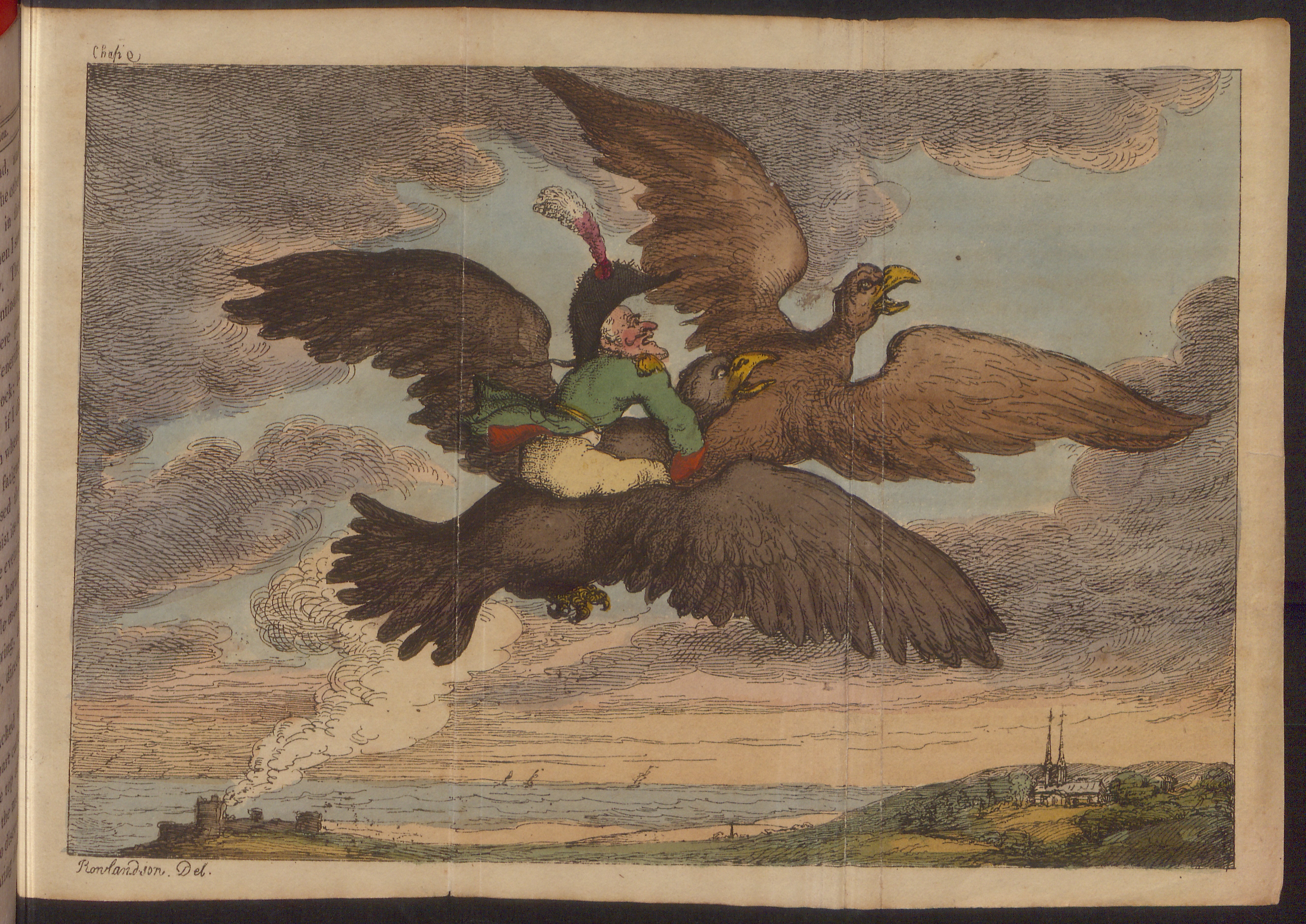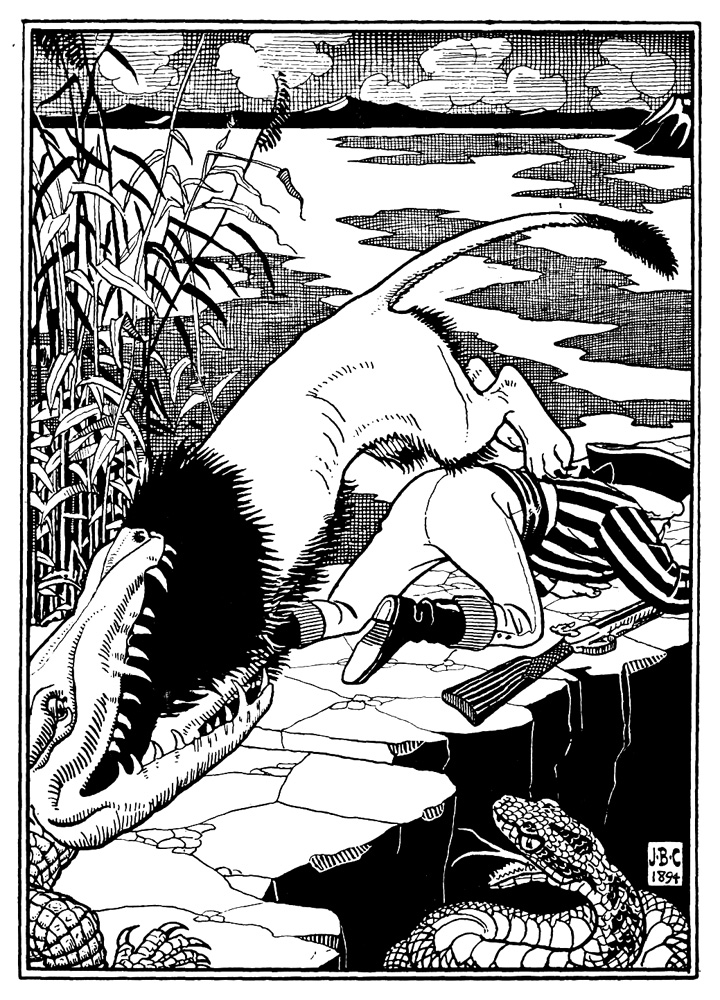A new German Edition of Baron Munchausen’s Adventures Sparks a Lively Intercultural Exchange
Munchausen is a familiar name in literature as well as in psychology. ‘Munchausen Syndrome’was first diagnosed in 1951 by Richard Asher as a psychiatric disorder. Since then variants of the syndrome have been identified, including ‘Munchausen by Proxy’ and even ‘Munchausen by Internet’, where people affected by the disorder use the much enhanced possibilities of the internet to create stories of imaginary illness.
The baffling name stems from the literary figure of Baron Munchausen. His adventures were published worldwide in sundry editions and sixty languages. He is well known in Russia and France, in Japan and Mexico. England and Germany, where his reputation is highest, both claim him as their own – with some justification. The real Baron Münchhausen, on whom some of the stories are based, originated in Germany, but his name, partially anglicised to ‘Munchausen’, appears for the first time in a 1786 text written in English and published in London by a German émigré, Rudolf Erich Raspe.
In Germany public perception is somewhat different. Gottfried August Bürger, first translator of Raspe’s English original, is credited as creator of the original work, and numerous children’s books are based on his translation. This wouldn’t be a problem – different cultures create their own history of literature –, but for one pertinent fact: Bürger only translated Raspe’s first volume. The second, published in London in 1792, was completely unknown in the Germanspeaking world until now.
Newly translated and edited by Bernhard Wiebel and Stefan Howald, this edition is the first to present both of Raspe’s volumes in German. Wiebel is an accepted authority on Münchhausen/Munchausen, and has established a private library of some thousand books on the subject (www.munchausen.org), a collection which also takes in Münchhausen in art, in film and on tv, on cigarette packets, playing cards, mugs, as parlour games and so on.
In England, Raspe may be credited with authorship of the book (the British Library lists dozens of Munchausen editions under his name), but this fascinating Enlightenment intellectual is all but forgotten as a figure in his own right. Born in 1736 in Hannover, he studied in Göttingen, became a librarian in Hannover, then in Kassel. Alongside his work, he discovered and published unknown manuscripts by Leibniz, wrote a drama, started a magazine in the tradition of the Spectator, and began to explore Germany’s volcanic landscape.
But then an incident occurred worthy of one of Munchausen’s fantastic adventures. His salary being rather meagre, Raspe began selling some of the valuable coins owned by his employer, the Landgraf Friedrich II of Hessen‐Kassel. Raspe had catalogued the coins in his usual thorough and systematic way, making it relatively easy for the missing items to be spotted when his employer took an interest in the collection. In 1775 therefore Raspe fled, pursued by a police warrant, to London. In recognition of his work on German volcanoes Raspe had, in 1769, been elected a member of the Royal Society but, when news of his disgrace reached England, his world collapsed. Nonetheless he began working with Georg Forster on a German edition of Forster’s book about his first voyage with James Cook, and translated Lessing’s Nathan der Weise into English (available at the British Library). To earn some money he used his expertise as a geologist to work for the entrepreneur Matthew Boulton, exploring possible mineral deposits in Cornwall, and started another inventory, this time for an English art dealer cataloguing the 12,000 precious stones belonging to the Russian Empress, Catherine the Great. In between, in 1786, he published, anonymously, a small booklet containing some adventures and yarns by Baron Munchausen.
These stories were not original. In 1781 a journal in Berlin had printed some anecdotes of the fantastical endeavours of a somewhat cryptically named ‘M‐h‐s‐en’ during various hunts and military campaigns. Contemporary readers might have identified this person as Hieronymus Carl Friedrich von Münchhausen who had fought in two Russo‐Turkish wars and had settled in Bodenwerder near Hannover, creating a name for himself in the area as a narrator of tall stories. Raspe translated these eighteen tales into English, adding some of his own. Published in London, the anthology proved a success, on which Raspe quickly built, so making Baron Munchausen/Münchhausen into a figure in his own right.
 In Göttingen Gottfried August Bürger, another underrated figure of the German Enlightenment, read the booklet, translated the second edition into German and published it, also anonymously, in the same year. Two years later, in 1788, he produced an enlarged edition based on the enlarged fifth English edition. Bürger’s translation has much merit. Indeed, he enriched Raspe’s book with two of the most famous episodes – Münchhausen’s ride on a cannon ball, and an adventure in which the Baron averts mortal danger by lifting himself and his horse out of a swamp by the pigtail of his own wig. These episodes were later to return to England via a French edition illustrated by Gustave Doré. As Doré’s illustrations became internationally famous, they were taken over by some English publishers who also adopted the French text, itself inspired by Bürger’s German translation, as their original source.
In Göttingen Gottfried August Bürger, another underrated figure of the German Enlightenment, read the booklet, translated the second edition into German and published it, also anonymously, in the same year. Two years later, in 1788, he produced an enlarged edition based on the enlarged fifth English edition. Bürger’s translation has much merit. Indeed, he enriched Raspe’s book with two of the most famous episodes – Münchhausen’s ride on a cannon ball, and an adventure in which the Baron averts mortal danger by lifting himself and his horse out of a swamp by the pigtail of his own wig. These episodes were later to return to England via a French edition illustrated by Gustave Doré. As Doré’s illustrations became internationally famous, they were taken over by some English publishers who also adopted the French text, itself inspired by Bürger’s German translation, as their original source.
In Germany however, there was only one ‘original edition’, namely the text by Bürger. In the twentieth century Erich Kästner created the most successful adaptation for children, and wrote the script for the first and very successful film about Münchhausen. Produced in Nazi Germany in 1942 it is an ambivalent undertaking – made for war‐time entertainment and to enhance Germany’s reputation in the field of technically advanced film‐making –, Münchhausen boasts some impressive scenes and creates an emblematic picture of actor Hans Albers riding on a canon ball.
However, both Bürger and Kästner left out some elements mainly of interest to the English reader, and neither Bürger nor Kästner were aware that Raspe had published a supplement as well as a sequel in 1792. Astonishingly both volumes were to remain unknown in the Germanspeaking Münchhausen tradition for the next two hundred years.
The present edition presents a new Münchhausen. The second volume comprises three main strands which significantly correct the image in Germany of Münchhausen as a buffoon and a blunderer. The sequel contains more literary persiflage, is profoundly interested in discussions of technological progress and science and is more topically satirical. From the third edition of the first volume onwards, Raspe’s book was entitled Gulliver Revived, or, The Vice of Lying Properly Exposed, and had Jonathan Swift as a focal point. In the second volume Raspe engages with other authors, for instance with Oliver Goldsmith, with Sterne or Cervantes. Cervantes’ Don Quixote enters the scene as a ‘real’ figure (in the fiction which is Munchausen), and his disputes with Baron Munchausen are written as a parody of Cervantes’s parodistic style – resulting in somewhat long‐winded passages, but which illustrate interesting cross‐cultural breeding. On the other hand, Raspe quite cleverly recreates Sterne’s satirical dealing with sentimentality: his infamously suggestive chapter in Tristram Shandy about ‘whiskers’, for example, is reconstructed by Raspe, but with slightly more political edge. Munchausen’s interest in technology is most particularly reflected in ways of conquering the air. He encounters balloons – only invented by the brothers Montgolfière some ten years before –, he rides and directs an eagle to circumvent the globe, and demonstrates the balloon’s capability of lifting heavy loads by raising the building of the Society of Physicians into the air and holding it there for months – during which time nobody dies in London.
First and foremost, Raspe’s sequel deals with the topical race to Africa, politically as well as economically and scientifically. There is a passage in which the Baron encounters a fleet of ‘Negromen’ on the coast of Guinea, ships on which black slave‐owners transport white slaves to the South Pole where they are set to work on plantations. Munchausen – aggrieved by this barbaric practice and especially by the reasoning of the black slave‐owners that whites don’t possess a soul and so are not entitled to a humane life – conquers the ships, liberates the white slaves and throws the black crews into the water. This scene reproduces as a mirror image the infamous case some years previously of the slave‐ship Zonga, when a captain ordered one hundred and forty black slaves to be thrown overboard, following which the owners of the vessel attempted to claim compensation from their insurer for lost profits – a shocking court case which advanced the abolitionist cause.
In Africa Munchausen attempts to introduce English manners to the indigenous population – an endeavour which allows Raspe a piercing critique of the kind found in Montesquieu’s Lettres persanes, or in Swift’s work, or indeed Adolphe Freiherr Knigge’s Benjamin Noldmanns Geschichte der Aufklärung in Abyssinien, published in the same year as Raspe’s sequel. Some of Raspe’s stories are specifically concerned with English matters, for example a hilarious account of a Lord Mayor’s Show, or Munchausen’s raising of the hull of the HMS Royal George, a Royal Naval vessel which had seen distinguished service but had sunk with the loss of more than eight hundred lives during routine maintenance work in 1782. But his hero is also caught up in the French revolution, saving Marie Antoinette from the Unholy Trinity of Rousseau, Voltaire and Beelzebub – alas not to much avail.
Overall Raspe’s sequel amounts to a wide‐ranging discussion of Europe on the brink of modernity. For instance, during an expedition to find the Northwest Passage, Munchausen is distracted by his hunting instinct and pursues a polar bear. Having killed it, he is encircled by hundreds of bears, but putting on the dead bear’s skin, he gains their confidence, only to slaughter all of them afterwards – so demonstrating the unleashing of commercial and technological advances to deadly effect.
The new German edition depicts the historical background to all the stories and is richly illustrated, presenting the international tradition and impact of the multicultural figure of Munchausen/Münchhausen, and providing an innovative addition to European culture and cultures.
Stefan Howald, Dielsdorf, Switzerland
Rudolf Erich Raspe: «Münchhausens Abenteuer». Übersetzt, herausgegeben und kommentiert von Stefan Howald und Bernhard Wiebel. Gestaltet von Helen Ebert.
Stroemfeld Verlag. Frankfurt/M 2015. 272 Seiten, 55 Illustrationen. 34 Euro/38 sFr
This text was first published in: «Friends Newsletter» November 2016. Friends of Germanic Studies at the Institute of Modern Languages Research at the University of London. London 2016.








